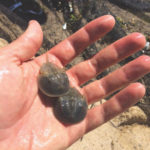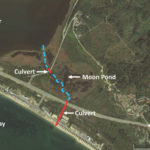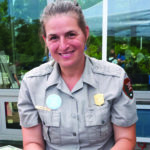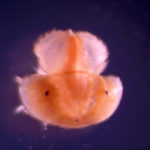TRURO — Since the once-thriving salt-marsh ecosystem called East Harbor was partially reopened to tidal flow in 2002, ocean organisms have been rapidly recolonizing the estuary. Researchers now hope to understand its changing ecology by documenting the success of horseshoe crabs, which have recently been found spawning in East Harbor (sometimes called Pilgrim Lake).
Scientists from the Cape Cod National Seashore, the Center for Coastal Studies, and Antioch University of New England are about to dig into two projects to collect baseline data and document horseshoe crab behavior in the partially restored tidal lagoon. The work, to begin in April and continue for two years, builds on an effort that began in 2018 and was slowed by the government shutdown the following year.

This research is significant not only because of the importance of horseshoe crabs as a species but also because it may help predict how other degraded estuaries will respond to the restoration of tidal flow.
Sophia Fox of Wellfleet, an aquatic ecologist at the Seashore, is leading the next phase of the horseshoe crab study. She said the status of East Harbor is not well documented. “This will be the first study to look comprehensively at what the conditions are in different parts of the system,” she said. “It’s very exciting. There’s a whole lot going on, and we feel it’s high time to start studying it.”
East Harbor was cut off from tidal flow in 1868 when a natural inlet connecting it to the bay was diked to build the railroad. The 720-acre salt marsh lagoon became anoxic — depleted in oxygen — and native vegetation died out.
In 2001, those low oxygen levels in the water caused a massive fish kill, prompting Truro to take action. The town replaced the one-way clapper valves in a culvert under High Head Road with two-way valves, which allowed salt water to enter the degraded system. Now ocean organisms, including horseshoe crabs, are able to reach East Harbor by swimming through two culverts. The first runs under Route 6 from Cape Cod Bay into Moon Pond. The second runs under High Head Road, connecting Moon Pond and the southwest corner of East Harbor.

Since those two-way valves were installed, changes have been rapid. Ocean organisms reentered the lagoon and the water quality improved. “That system is in a great place, considering how little tidal flow it’s getting,” Fox said.
Scientists first discovered horseshoe crab molts — the crabs shed their shells as they grow — in East Harbor in 2008. More recently they found evidence of horseshoe crab nests, suggesting that the crabs use the lagoon as a nursery — a protected area where crab larvae can hatch and grow. Fox said that the new study will attempt to find where horseshoe crabs are spawning and how quickly they move in and out of East Harbor. She is especially keen to see how crabs navigate through the two culverts.
The findings could be key to supporting the comeback of the crabs and may bolster other tidal restoration efforts in Truro and beyond, though East Harbor is unique in that it faces fewer challenges from fishing, aquaculture, and development than many other ecosystems do, according to Fox.
Horseshoes’ Importance
Because horseshoe crabs eat shellfish, they were in the past widely seen as a nuisance. Bounties were maintained on horseshoe crabs until 2000 in Massachusetts, resulting in the deaths of one million crabs annually.
Now appreciated as valuable, horseshoes are under pressure from overfishing and habitat degradation. According to the Seashore’s website, crab larvae are an important food source for shorebirds, and sharks and turtles prey on adult crabs. Humans fish for horseshoe crabs as bait for eels and whelk. And they are used in biomedical testing: Limulus amebocyte lysate, produced from horseshoe crab blood, is used to detect bacteria in injectable drugs and implantable medical devices. About 160,000 horseshoe crabs were harvested in 2018.
In recent years, however, the population has been recovering.

Derek Perry, a biologist at the Mass. Div. of Marine Fisheries, said that horseshoe crab stocks are growing north of Rhode Island. According to the 2018 horseshoe crab compliance report, their relative abundance has been increasing since 2010 along Cape Cod’s southern shores.
Perry attributes the recent population growth to better regulation, with the state limiting the number of horseshoe crab fishing permits issued and establishing legal size limits.
In 2010, Massachusetts established a lunar fishing closure, preventing fishing when horseshoe crabs are spawning, typically during full moons. The crabs lay their eggs at extreme high tides above the high-water mark so they will not be washed away by subsequent tides.
Perry is excited about the study’s focus on juvenile crabs, which could provide more immediate feedback on changes in regulations, he said.
Marine Fisheries already conducts annual spawning and trawl surveys, but young horseshoe crabs are not counted. Only adults older than nine years are large enough to be captured in trawl surveys. Thus, population growth cannot be documented until the new generation of crabs grow large enough to be captured. “If a regulation goes into place, the survey won’t pick it up for a decade,” Perry said.

It may prove difficult, however, to accurately monitor the juveniles. “It’s tricky because they are spotty,” Perry said, explaining that baby horseshoe crabs tend to congregate. In a coastal lagoon, some areas may contain no juveniles, while a few square meters may hold thousands, he said.
Fox has a plan for that. While adults will be marked with an acoustic tag that communicates with buoys stationed in the lagoon, juveniles will be tagged visually and then recaptured. Scientists here will use a time-intensive method to observe them, recording the location and size of each crab, along with other information, Fox said.
More Restoration in Store
The horseshoe crab study will coincide with another East Harbor study to document sea floor sediment characteristics, nutrients, phytoplankton, and small invertebrates living in surface sediments in the lagoon, Fox said. “If we understand the underlying environment that the crabs live in, that may explain the distribution of where we see them in the estuary,” she said.
Both Perry and Fox said fully restoring East Harbor would benefit horseshoe crab populations and the ecosystem as a whole.
East Harbor’s tidal range is 8 to 12 inches at present. This small range prevents horseshoe crabs and other organisms from accessing the marsh surface, where food is plentiful. Rising temperatures can also stress organisms, Fox said.
“With more frequent tidal flushing, maybe there would be a more constant tidal temperature. The tide also brings in a lot of nutrients and food,” Fox said. “There’s a lot of value in getting more tide into East Harbor.”



